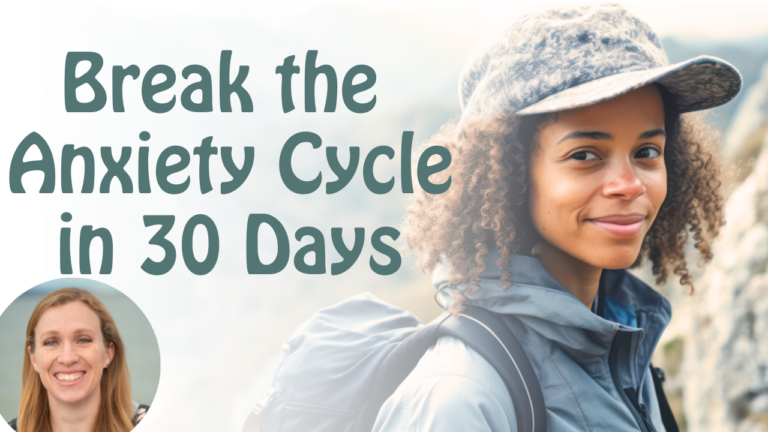In this post, you’ll learn the difference between relaxed vigilance vs. hypervigilance.
This is seriously one of the most powerful interventions I know of for chronic anxiety.
It uses a bottom-up approach, a body first approach to regulate your nervous system to reduce stress and anxiety throughout the day. And it’s pretty simple to learn.
Stress is an Autonomic Nervous System Response
OK, so stress is a nervous system response, it’s your autonomic nervous system responding to perceived threats, whether they be in your environment (dog barking) or in your head (What if no one likes me). We also have a counterbalancing response, the parasympathetic response, para as in parachute, it slows things down and helps restore a sense of calm, both in our mind and in our body. We don’t have direct control over our autonomic nervous system, but we can influence it in a powerful way.
Microtriggers
When it comes to anxiety, the stress response isn’t kicking on due to a huge immediate threat- like a saber tooth tiger, it’s turning on in tiny doses throughout the day in response to micro-triggers, tiny little stressors that we might not even be aware of.
So for example, let’s say you’re a professor and throughout your day you have all these little things come up. Meetings explaining changes to the curriculum, Students worried about an exam, students emailing you to change their grades so they can get into medical school, co-workers who are helpful and coworkers who are less than helpful. And each time one of these things comes up, without realizing it, your body kicks off a little ANS response, a stress response. Your heart rate increase, muscles tense, your digestion gets messed up, you breathe faster or hold your breath.
Changes in the curriculum- that means more work for me. What If I don’t have the energy? (brain interprets this thought as a threat). Student upset about the exam score – (what if they are a threat to me (the brain interprets rejection as a survival threat)) a coworker who is helpful- a sense of safety or relief, a coworker who is spicy- this is a potential threat. So the stress response gets triggered in tiny doses throughout the day.
Resilience
Now here’s the thing, each of us, and our brains, and our nervous systems are super-resilient, when we face a challenge – like an upset student, we sit down and think about it (Is this really a threat? No, I am safe. I am doing what’s right by holding boundaries and there are lots of people who will support me in doing my job) then we can resolve that threat and the parasympathetic response can kick on in our body. Our nervous system is designed to activate and then to face a problem and then relax.
But the problem is that we are often too busy, or too distracted, to address each micro trigger and face it and resolve it, so instead that stress response just builds and builds throughout the day. Each little stressor piling on, and our bodies remain stuck in a physical FFF response throughout the entire workday, until we go home, collapse onto our couch, and watch netflix.
At this point, we are turning on the relaxation response, but really the problem of the day is simply getting put on hold, we’re just distracting ourselves from it, trying not to think about it, and that stress response kinda gets stuck in our bodies.
This is one reason relaxation is better than just staying busy all the time, but there’s something a lot more effective at managing anxiety. You see, relaxation is a form of getting stuck in the stress response and then escaping the stressor to relax, it contributes to the anxiety cycle with another form of avoidance.
Instead I’m going to teach you a more effective long term strategy for resolving stress and anxiety, it’s self-regulation.
Self-Regulation
What if, instead of stuffing and avoiding that anxiety response throughout the day, instead of just white-knuckling our way through the day, we learn instead to resolve that stress response in tiny moments throughout the day? Instead of those stress hormones and the tension building and building, instead of running a stress marathon the whole day long, we soothe our body throughout the day?
This is the essence of self-regulation, you can learn to regulate your nervous system through the day, through really simple skills. And this does two things, it keeps you relaxed throughout the day, your body isn’t stuck in the FFF response all day, and 2) it trains your nervous system to be parasympathetically dominant. It strengthens your ability to turn on that calming response.
And, we can even do it during stressful events, we don’t have to wait until the stressors are gone to soothe our nervous system.
So, how do you do it? It’s easy to learn, but takes some effort to practice.
First- Awareness. You have to check in with your body frequently. Most of us are completely unaware of the state of our nervous system. Are you in Safety, Activation, or Immobilization? Hopefully the previous chapters have helped you identify what these different states feel like. So now, you need to create a habit of checking in with your body throughout the day. I recommend that you use the app “Lotus bud”. It has random chimes that go off throughout the day, when the chime goes off, just check in with your body- are you feeling tight, holding your breath? Poor posture, tense? Or are you relaxed and gentle?
Second: Use your favorite grounding skill to simply turn on the parasympathetic response in the moment. Take a slow breath. Yawn. Tense and release a muscle. Or something like that. It might also help to say “I am safe enough right now”. As you practice relaxing your nervous system, you’ll retrain your system to be calm throughout the day, even in situations that require a lot of focus, attention or performance.
I recommend that you set this timer to go off about every 15 minutes for the first week you are learning this. It’s really important that the first week, you don’t ignore the timer. Every single time it goes off, scan yourself, and then just use a grounding skill to turn on that relaxation response.
Remember, you can’t force it. If you catch yourself getting into a struggle with your feelings or sensations, just go back to willingness- be present, open, and curious about your emotions. Allow them to be there. You can handle having feelings. You can’t force it. You can train it. You can regulate it. You can coach it downward. You must ground on acceptance first, not force. Like any good relationship.
Seriously, that’s about it. That is how you regulate your nervous system.
Relaxed Vigilance
Ok, there’s one more thing I want to address. There’s a false dialectic, it’s this idea that if the outside situation is stressful, I must feel stress. Can we challenge this? Can you do a stressful thing without being stressed? Let’s experiment with this.
- When we believe a situation is what causes our stress response, we create helplessness around our stress levels.
- There is another way to think about this-We can train our minds and bodies to separate the situation from the response.
- Learning to have a calm nervous system, even in intense situations is a skill that you can develop. It’s called relaxed vigilance.
Now I didn’t know there was another way to do it. I didn’t know that there was a way to be in a high pressure environment without taking that stress inside of me. When I grew up, the way to be busy was to be stressed out. Just like that professor, I thought that if I was at work, I had to be keyed up, in the stress response, and the only way to get out of it was wait for the weekend or a vacation.
After years of this I went to a PTSD professional training, and the facilitator, Eric Gentry taught me how he trains E.R. doctors and military operatives and other people with high-stress jobs to be busy and vigilant while maintaining a calm nervous system. He calls the skill “relaxed vigilance”.
So can you do a stressful thing, without being stressed? Experiment with this.
Watch the video of the biker from the beginning of the course. Can you calm your body while you watch it? Practice.
We can accidentally train ourselves to do stressful things with a tight-stressed out nervous system, or we can intentionally train ourselves to do stressful things with a relaxed but alert nervous system. The best athletes, surgeons, cops, special forces, they train and build up skills to handle situations. They drill and practice and follow their routines until they feel confident in what to do, then, the healthy ones, maintain a calm nervous system even in the face of life-threatening situations.
I’m going to include a story of how I learned this stuff in the full course, as an added resource for this lesson.
OK, so back to that professor. After she learned to identify the 3 states of her nervous system, she started to notice how tight and stressed she was getting throughout the day. She found that it especially happened before she taught, when she answered emails, and around exams. She asked herself “What is the perceived danger?” with a little exploration, she realized that she was afraid of rejection, afraid of not being liked, and as soon as she realized that, she realized that she wasn’t actually in danger, it’s ok if some of her students didn’t like her. She is safe. So she set a timer on her phone, a little notification that reminded her to regulate her nervous system. She used a slow out-breath sometimes, other times she’d fake a yawn, sometimes she’d do a little tense and relax of her muscles. After a while, all it took for her to relax was to just notice that she was feeling uptight and stressed, she’d make a soft smile and soften up a little. Within a few weeks she noticed that she started to have a lot more energy after work, she wasn’t exhausted every single day, and she started sleeping better too. Over time her stress levels went way down, she didn’t feel like she was carrying such a heavy stress load.
This simple skill, of moment to moment nervous system regulation, is one of the most effective ways to manage anxiety throughout the day, when you calm your body, the vagus nerve sends a message to your brain to calm your mind as well. As I was writing this video it gave new meaning to the popular phrase “Life isn’t about waiting for the storm to pass, it’s learning to dance in the rain” ? Dancing is a parasympathetic cue. We can all learn to soothe our nervous system, even when we have important, busy or stressful work to do. Please give it a try and let me know how it goes.
Click the link below to check out our latest course, Break the Anxiety Cycle in 30 Days.





